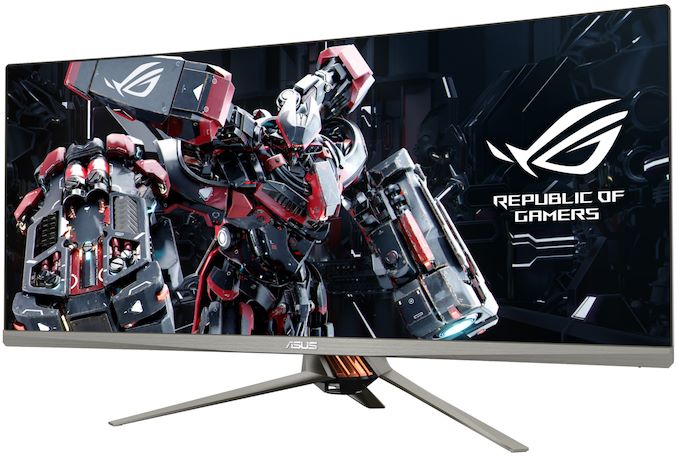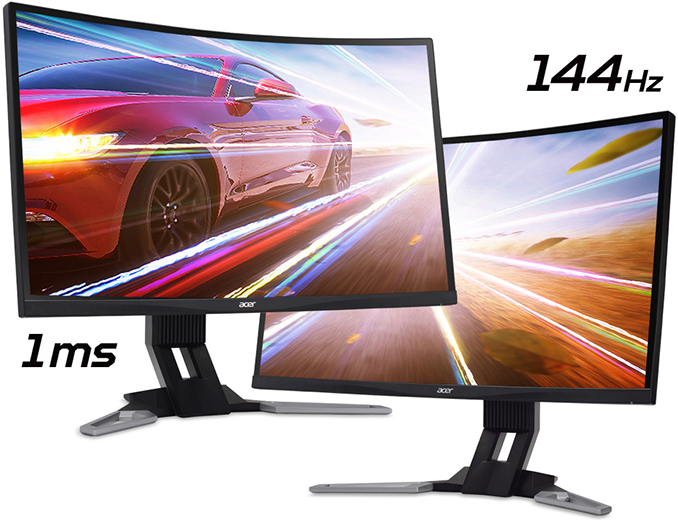Sales of High Refresh Gaming Displays Skyrocketing, Curved Gaming LCDs Prevail
by Anton Shilov on December 7, 2018 2:00 PM EST- Posted in
- Displays
- Acer
- Samsung
- Asus
- BenQ
- AOC
- Monitors
- Market Trends
- Philips
- Curved Display

The number of news stories about gaming displays that we post has increased significantly in the past couple of years. Established suppliers have broadened their lineups of gaming LCDs, and meanwhile new players have decided to join the party. Apparently, our coverage has been reflecting market sales trends, as sales of such monitors have been increasing at a rapid pace. According to WitsView, shipments of displays with a 100 Hz refresh rate or higher (i.e., gaming LCDs) will exceed five million units in 2018. Moreover, over half of them will be curved monitors.
Curved Gaming LCDs Leave Flat Displays Behind
Global sales of gaming displays with high refresh rates are expected to reach 5.1 million units in 2018, an annual growth of 100%, reports WitsView, a division of TrendForce. This is still a small fraction of the 126 million total LCDs projected to be sold in 2018 (up 1.5% year-over-year), according to the company. The researchers attribute the growing demand for displays with high refresh rates to recommendations from game developers, with groups such as the PlayerUnknown's Battlegrounds devs recommended 144 Hz+ displays. Meanwhile, it is evident that as the number of available models on the market is increasing, their prices are getting lower and gamers are more inclined to buy them.
One interesting point about gaming displays in general is that 54% of gaming LCDs sold this year will be curved monitors, leaving only 46% of them to be flat. Last year 77% of gaming displays were flat and only 23% were curved, according to WitsView. Shipments of around 2.75 million units is a big win for curved LCDs at large. In fact, keeping in mind that there are even more numerous curved models with refresh rates below 100 Hz, it is safe to say that sales of such displays in general will clearly surpass 5 million units, up from around a million in 2015. Since price difference between curved and flat monitors is diminishing, curved displays are no longer penalized with a price premium.
ASUS Leading the Pack
When it comes to suppliers of gaming displays, ASUS has been leading the pack for quite a while now, and this year was no exception. Acer maintained its second spot in 2018. By contrast, BenQ left the Top 4 and the third place now belongs to TPV, which sells products under AOC and Philips brands and is particularly successful in the Chinese, European, and APAC markets. Samsung moved up to fourth place (from the No. 5 spot) after expanding its gaming lineup with numerous new models in 2017 – 2018 timeframe, including the world’s first FreeSync 2-supporting monitors and numerous curved models of various sizes. It is noteworthy that 95% of Samsung’s gaming displays are curved.
| Top Suppliers of Gaming LCDs in 2017 - 2018 Data by WitsView, December 2018 |
|||
| Ranking | 2017 | 2018 Estimation |
|
| 1 | ASUS | ASUS | |
| 2 | Acer | Acer | |
| 3 | BenQ | AOC/Philips | |
| 4 | AOC/Philips | Samsung | |
| Shipments | 2.5 million | 5.1 million | |
Other vendors with impressive sales growth in 2018 noted by WitsView are MSI, HKC, and SDC. The latter two are particularly successful in China, whereas MSI is promoting its Optix gaming displays globally. Meanwhile, general LCD market leaders like Dell, HP, Lenovo, and LG are not exactly among the frontrunners on the market of gaming monitors.
| Top LCD Suppliers: 2017 - 2018 Data by WitsView, October 2018 |
|||||||
| 2017 | 2018 (Estimated) |
||||||
| Ranking | Brand | Market Share | Ranking | Brand | Market Share | ||
| 1 | Dell | 18.5% | 1 | Dell | 19.6% | ||
| 2 | AOC/Philips | 13.5% | 2 | HP | 13.8% | ||
| 3 | HP | 12.7% | 3 | AOC/Philips | 13.1% | ||
| 4 | Lenovo | 9.8% | 4 | Lenovo | 9.6% | ||
| 5 | Samsung | 9.6% | 5 | LG | 8.7% | ||
| 6 | LG | 9.3% | 6 | Samsung | 7.6% | ||
| 7 | Acer | 6.0% | 7 | Acer | 6.8% | ||
| Others | - | 20.5% | Others | - | 20.8% | ||
| Shipments | - | 123.7 million | Shipments | - | 125.6 million | ||
Related Reading:
- Acer Unveils KG1 Displays with Sub-1ms Response Time
- ASUS Lists ROG Strix XG32VQR Curved FreeSync 2 Display with RGB
- JapanNext Launches 35-Inch "UWHD" Curved LCD: AMVA & 200Hz Refresh w/FreeSync
- MSI’s 49” Optix Curved Display and Oculux 25” High Refresh Monitors Announced
- ASUS Announces ROG Strix XG32VQ and ROG Strix XG35VQ: Large, Curved, & Fast
- Smooth As 240 Hz Butter: LG's 27GK750F-B, a 27-inch eSports Monitor with FreeSync, Launched for $550
- BenQ Announces ZOWIE XL2546 ‘eSports’ Display: 24'', FHD, 240 Hz, DyAc ULMB Tech
Source: WitsView/TrendForce











75 Comments
View All Comments
abufrejoval - Sunday, December 9, 2018 - link
With a 55" OLED I think "smart money" choices are the least of his concerns...I only got a 43" 4K IPS and all I can say is that the GTX1080ti didn't cut it for ARK Evolved, while the RTX2080ti seems above lag. Its raytracing capabilities may be for naught, but those 30% extra power made it all worthwhile for 4k.
nathanddrews - Monday, December 10, 2018 - link
Assuming he bought the OLED on sale/clearance, it's very easy to find 55" LG 4K OLED displays under $1200 over the course of a given year, which isn't that ridiculous. I'm not one to talk though, I'm using my 1080Ti with both a 65X930E and GDM-C520K (depending on the application).B3an - Saturday, December 8, 2018 - link
Curved displays are just another backwards fad. Just like 3D displays, but this is even more retarded as 3D was optional, but here you're paying for a bent distorted screen, where even if you sit in literally the ideal position it's still going to be distorted. It's the inverse of a 90's CRT. People are such utterly pathetic sheep and never learn.Black Obsidian - Saturday, December 8, 2018 - link
Spotted the poster who has never actually compared large curved and flat monitors.At a certain size, flat monitors appear to be curved *away* from you, because their edges are noticeably more distant than their center. Curved monitors solve (or at least reduce) this problem because the curve helps keep the edges (relatively) as close to you as the center.
Go compare curved vs. flat 34" ultrawide monitors if you want to see this effect at such an obvious scale that it's impossible to ignore.
Lolimaster - Saturday, December 8, 2018 - link
Ultrawide obviously exaggerate the "curve" effect on a big display, not really a common case. And you need to be close to the screen.So if you use the display just for you at a close distance then a curved display on a big ultrawide "makes sense".
Valantar - Sunday, December 9, 2018 - link
If by "close distance" you mean regular desk viewing distances, sure. I have a 27" 1440p monitor, which to me is perfect when sitting at my desk. When it eventually dies, I'm thinking I'll get a ~35" 1440p ultrawide, which is the same height, but wider. As such, it's obviously going to be used at the same distance, as moving away from it would be entirely counterproductive. A curved panel would then be a must, as it would make the edges of the panel more easily visible. At my optimal viewing distance the 27" panel already fills the entire in-focus area of my vision, so going wider and not getting a curved panel would be asking of eye strain both due to having to move my eyes more (panel edges further away from the eyes) and having to refocus to see the edges of the panel properly. I don't think curved panels make sense at 16:9, at least not below ~32", but at 21:9 it's a must."If you use the display just for you" - these are PC monitors we're discussing, not TVs.
B3an - Sunday, December 9, 2018 - link
I've compared them and they're gimmicks. They're also 100% useless for any sort of design/art work. A flat panel, even when quite large and close to you, still gives a vastly better impression of basic things like straight lines and perspectives when compared to a curved display.The fact they also only curve in just one direction - horizontally - is also unnatural and doesn't work well with how the human brain visually interprets things in comparison to something that is simply flat.
Until we have something like VR with 8K+ res for each eye, 200+ degrees field of view, that's also light, wireless, has no lens distortion and is extremely comfortable, then flat panels remain the best option for accurate viewing.
nathanddrews - Monday, December 10, 2018 - link
If only Rembrandt had known to use curved canvas...Beaver M. - Tuesday, December 11, 2018 - link
http://2.bp.blogspot.com/-ytbvAidUzVw/Urj8CSyFU9I/...Not Rembrandt, but you get the... picture.
YES, pun intended!
nathanddrews - Tuesday, December 11, 2018 - link
LOL that's so funny.